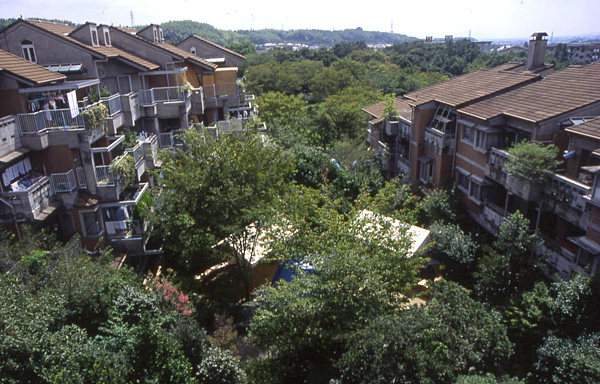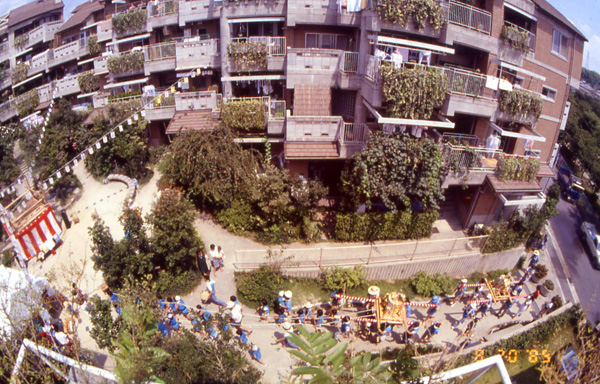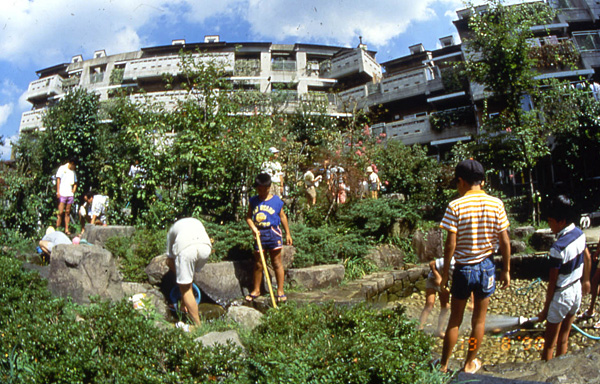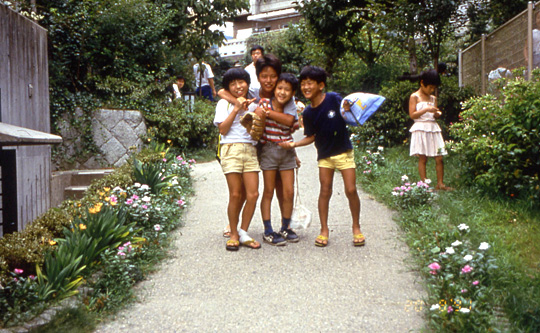“proto-cohousing”U Court
by Diana Leafe Christian
Penny’s and my favorite conference presenter was Professor Yasuhiro Endoh of Aichi Sangyo University in Nagano. An older man in perhaps his early 60s with an amiable expression and an unmistakable air of warmth and friendliness, Professor Endoh travels the length of Japan advocating “collective housing” through his nonprofit, “Team of Green Growth.” He showed slides of a successful 22-year-old collective housing development in Kyoto, “U Court.” The project, completed in 1985, consists of 48 units in three buildings of from three to five stories each. The buildings are arranged around a south-facing “U”-shaped courtyard surrounding tall trees and a patio. U-Court doesn’t have a common kitchen/dining room. However, with a shared meeting hall, all stairwell entries facing into the courtyard so people meet their neighbors daily, open and shared ivy-covered balconies that serve as outdoor hallways running along the courtyard side of the buildings, and parking out of sight in one corner of the property, it sure seemed like “proto-cohousing” to me.
Professor Endoh emphasized the importance of trees and the natural environment in creating community. U-Court residents debated whether to plant trees in their central courtyard, which would have been expensive for them, but finally did plant trees. The presence of these trees later made all the difference in cooling the building, adding a beautiful, shady outdoor place for neighbors to gather in spontaneous as well as planned meetings, picnics, and celebrations. U-Court residents also all grew ivy up the sides of the buildings and especially across their shared balconies. At first they couldn’t get flowers and shrubs started along courtyard walkways because their toddlers would gleefully rip them out. So U-Court parents waited until the children were slightly older and asked them to plant flowers and shrubs and water them. The kids leapt into the project and proudly cared for the landscaping for years, later noting how important it had been to them return from school everyday and feel welcomed home by natural beauty. The parents also considered building a small round pond for the children to wade and splash in. While some were concerned it would be unsafe, they finally did build a pond, and it became the centerpiece of the children’s experience of the courtyard as they grew up. “You can’t believe the happy memories people who’d grown up at U Court had when they came home from school only to find that one of the men had gotten drunk and fallen into the pond again,” Professor Endoh explained, showing a photo of a man half-lying in a shallow pool, submerged up to his armpits, a silly grin on his face. Nature, ponds, and water are so important to Japanese people that one pair of neighbors created a small fishpond on their shared balcony and stocked it with koi.
Professor Endoh’s longitudinal study of the of young adults who’d grown up at U-Court indicated that they had loved the natural environment there and their sense of safety and connection to so many adults who served as substitute aunties and uncles. Like kids raised in community anywhere, they were much more confident and socially developed than their counterparts who’d grown up in conventional housing. And, not surprisingly, they wanted to move back to U-Court to raise their own children there too.










